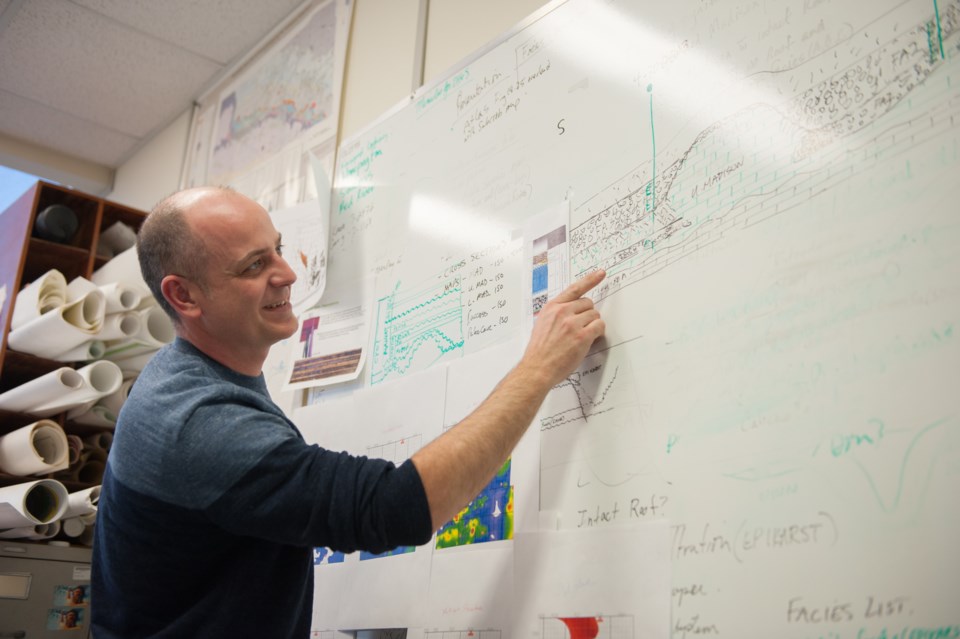Regina – In early July, the world was enraptured with the plight of 12 Thai soccer players who were led by their coach four kilometres deep into a cave, only to be trapped by rising waters from heavy rains. Their rescue, and the tragic death of one of their rescuers, brought caves very much into the public eye.
But long before that wayward journey into darkness, Dan Kohlruss, research geologist with the Saskatchewan Geological Survey, has been looking at caves for an entirely different purpose: how they may figure into the petroleum systems of west central Saskatchewan.
On Feb. 9, he spoke to Pipeline News about his work.
“Right now I’m working on the Success formation in west central, in the same area I was working on the Viking, but at a greater depth,” Kohlruss said.
The specific area is around Kindersley and Kerrobert – Marengo, Flaxcombe, Smiley, where several drilling rigs could often be found.
“I’ve been describing the various types of rocks there, and I’m finding they’re formed by karsting, and some of them are the result of cave development in the rocks.”
Karst features are the result of rocks that were dissolved, as a product of rainfall or water getting into fractures or cracks, according to Kohlruss. “When it rains, rain is always slightly acidic, and sometimes it comes into contact with limestone, and it will dissolve it along surfaces like cracks.”
This can result in vertical or horizontal caves.
This project idea has been at the top of his list for nearly 10 years, he noted.
“You have a limestone formation, the Madison. At its surface, you get karsting occurring and you basically get a rubble developed at the top. There’s been known oil shows in that for a number of years, and there’s been production,” he said. From Milton through North Hoosier, the reservoirs are part of this type of karst. “There’s also a collapsed cave that’s a reservoir. That’s cool, in my books.”
“I was able to map the collapsed cave system,” he said.
“It starts with the Madison limestone that was deposited in a sea, but then the sea went away, and you have a long period where the limestone is basically exposed to the elements. Just through rain and natural activity, you get these karsts forming. So the caves you see down in South Dakota, the same thing – but now those are in the subsurface and the caves have collapsed, but you can still get oil trapping in them.”
His paper is done, and now he’s working on showing the trapping model of karst-controlled reservoirs.
To identify this, he looks for angular beccia, or broken rock. “For it to have been like this, there was basically no lateral transportation, it’s all vertical collapse, otherwise it would all be rounded.
The cave walls had fallen inward, the ceiling had fallen down. Since the collapsed cave would be largely breccia, it would make for lots of porosity and permeability.
“What I’m finding, is where the caves are ending, you have oil trapped. Or, where some of the main part of the Madison is preserved, where the surface karst terminates against it, you have oil trapped,” he said.
The cave system Kohlruss is looking at would be in excess of 30 kilometres long.
“It may be more than one cave system that eventually coalesced,” he said.
The depth would be around 800 metres now. It would be 150 to 110 million years old.
For this project he looked at about 3,000 well logs, but only had about 16 cores that actually go through these intervals.
“It’s almost impossible to core. They pull up the core barrel and its gone, it’s so rubbly,” he said.
Kohlruss presented his findings in Salt Lake City and Calgary this past May.
“I’ve been talking about this to several companies in the area, and they’ve been waiting for me to publish the info. It’s going to change, I think, a few of their interpretations of how to look for the oil,” he said.
For instance, one company had been looking for fluvial (river channel) systems in the area. Kohlruss is suggesting it may not be river channels, but rather collapsed caves.
The oil in question is heavy oil, not light oil, he noted, which has an impact on its production.




